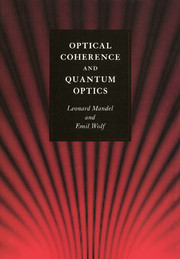Book contents
- Frontmatter
- Contents
- Preface
- 1 Elements of probability theory
- 2 Random (or stochastic) processes
- 3 Some useful mathematical techniques
- 4 Second-order coherence theory of scalar wavefields
- 5 Radiation from sources of any state of coherence
- 6 Second-order coherence theory of vector electromagnetic fields
- 7 Some applications of second-order coherence theory
- 8 Higher-order correlations in optical fields
- 9 Semiclassical theory of photoelectric detection of light
- 10 Quantization of the free electromagnetic field
- 11 Coherent states of the electromagnetic field
- 12 Quantum correlations and photon statistics
- 13 Radiation from thermal equilibrium sources
- 14 Quantum theory of photoelectric detection of light
- 15 Interaction between light and a two-level atom
- 16 Collective atomic interactions
- 17 Some general techniques for treating interacting systems
- 18 The single-mode laser
- 19 The two-mode ring laser
- 20 The linear light amplifier
- 21 Squeezed states of light
- 22 Some quantum effects in nonlinear optics
- References
- Author index
- Subject index
11 - Coherent states of the electromagnetic field
Published online by Cambridge University Press: 05 April 2013
- Frontmatter
- Contents
- Preface
- 1 Elements of probability theory
- 2 Random (or stochastic) processes
- 3 Some useful mathematical techniques
- 4 Second-order coherence theory of scalar wavefields
- 5 Radiation from sources of any state of coherence
- 6 Second-order coherence theory of vector electromagnetic fields
- 7 Some applications of second-order coherence theory
- 8 Higher-order correlations in optical fields
- 9 Semiclassical theory of photoelectric detection of light
- 10 Quantization of the free electromagnetic field
- 11 Coherent states of the electromagnetic field
- 12 Quantum correlations and photon statistics
- 13 Radiation from thermal equilibrium sources
- 14 Quantum theory of photoelectric detection of light
- 15 Interaction between light and a two-level atom
- 16 Collective atomic interactions
- 17 Some general techniques for treating interacting systems
- 18 The single-mode laser
- 19 The two-mode ring laser
- 20 The linear light amplifier
- 21 Squeezed states of light
- 22 Some quantum effects in nonlinear optics
- References
- Author index
- Subject index
Summary
Introduction
In our discussion of the classical electromagnetic field we found it convenient to describe the field by a complex amplitude, both in the frequency and in the time domains. The complex representation is convenient partly because it contains information about the magnitude and about the phase of the electromagnetic disturbance, and partly because of its analytic properties. These features turn out to be particularly useful for the description of the optical coherence properties of the field.
We shall see that an analogous quantum state of the field exists, leading to an interesting representation that is also particularly useful for the treatment of optical coherence. This coherent-state representation leads to a close correspondence between the quantum and classical correlation functions. The coherent states of the field come as close as possible to being classical states of definite complex amplitude. We shall find that coherent states turn out to be particularly appropriate for the description of the electromagnetic fields generated by coherent sources, like lasers and parametric oscillators; indeed it turns out that the field produced by any deterministic current source is in a coherent state. In the following sections we shall examine some of the properties of coherent states, and then go on to discuss representations based on these states.
Coherent states were first discovered in connection with the quantum harmonic oscillator by Schrödinger (1926), who referred to them as states of minimum uncertainty product.
- Type
- Chapter
- Information
- Optical Coherence and Quantum Optics , pp. 522 - 572Publisher: Cambridge University PressPrint publication year: 1995
- 5
- Cited by



